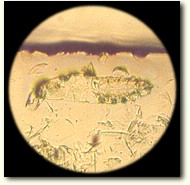 describe
any kind of mite infestation, Demodex is generally less severe than Sarcoptic
mite infestation.
describe
any kind of mite infestation, Demodex is generally less severe than Sarcoptic
mite infestation.Demodex in the dog is
a common infestation of the dog’s skin with tiny, cigar-shaped, eight-legged
mites. (Human demodex cases do occur but transmission from the dog to a human is quite rare. Nevertheless, human cases of demodex do happen where transmission from a family pet to a human occurs. See a case of demodex in a human below.) The mites reside and feed in the hair follicle and oil glands of the skin. Also
called Mange, which is a general term used to  describe
any kind of mite infestation, Demodex is generally less severe than Sarcoptic
mite infestation.
describe
any kind of mite infestation, Demodex is generally less severe than Sarcoptic
mite infestation.
Fortunately, most cases of Demodectic mites are self-limiting… that is, the animal is able to arrest the reproduction and growth of the mites and eventually repair the damage they do. Once eliminated, most dogs do not acquire another infestation; the dog’s immune defenses are primed to eliminate any new Demodex mites that happen to find themselves on the dog. However, there are certain individual dogs that, because of genetic programming, do not produce the specific immune factors that will target the mites for destruction. That specific lack of adequate immune defense against the mites is a hereditary aspect of the disease that can predispose an infested dog to a severe, unresponsive case of Demodex. Many veterinarians believe that all dogs have small numbers of Demodex mites residing in the skin and that having a few mites is normal and common. It is when immune related, or nutritional or environmental stresses impact the dog that visible skin lesions from mite infestations become noticeable. Seen most commonly in young dogs, and rarely in cats, Demodex skin lesions are usually transient, but occasionally in certain individuals the mites will totally overwhelm the dog's skin. See the photo below of a year old Doberman Pinscher with severe, generalized Demodicosis that was totally unresponsive to all attempts at treatment. Adult-onset Demodicosis is explained below.
QUESTION:
Can Demodex mites be inherited?
ANSWER: No.
The mites are not present on the fetus while the fetus is developing from
an embryo in the uterus. However, if the mother has Demodex mites present in/on her skin, the mites can invade the new
fetus’ skin immediately after birth. Since many dogs have Demodex mites
present in their skin, and never actually develop noticeable skin lesions, the mother may not even be showing
any signs of mites and yet transmit mites to the newborn pups. The pups
may or may not develop a clinical case of mites.
mother has Demodex mites present in/on her skin, the mites can invade the new
fetus’ skin immediately after birth. Since many dogs have Demodex mites
present in their skin, and never actually develop noticeable skin lesions, the mother may not even be showing
any signs of mites and yet transmit mites to the newborn pups. The pups
may or may not develop a clinical case of mites.
QUESTION: Why,
then, do I keep hearing that Demodex can be inherited.
ANSWER: The problem is the wording. The specific antibodies
that will defend against infestation of Demodex can be inherited and most dogs
have those immune factors and are able to defend against Demodex. But some
individuals have inherited a deficiency of those antibodies and just don't have
the ability to fend off the mites. So the ability to resist the mites, or
not resist, is inherited. The actual mites are not
inherited.
QUESTION: So if I
have a pup that has Demodex and it is only six weeks old and has never been in
contact with any dogs 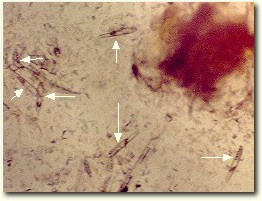 outside
our home, the mites must have come from the mother. But the mother has
never had Demodex so how could that happen?
outside
our home, the mites must have come from the mother. But the mother has
never had Demodex so how could that happen?
ANSWER: Your assumption that the mother dog has "never
had" Demodex is probably not valid. Demodex mites have been proven to
inhabit the hair follicles of many, many dogs, humans and other mammals without
causing the host any problems at all. So these mites can be present in
normal and healthy individuals (who have inherited the immune factors needed to
keep the mites suppressed). So just because you have not experienced a
visible skin lesion on your dog does not mean that the dog has no mites present.
QUESTION: If I
have a dog that has Demodex, does that mean I should not breed it?
ANSWER: If the dog, male or female, has a protracted,
difficult-to-cure case of Demodex, that dog should not be bred. If you
have a dog that has or had a brief, localized episode of Demodex and has
recovered well, then breeding may be considered; but some veterinarians believe
that any dog that has displayed skin manifestations of Demodex should be removed
from a high quality breeding program.
QUESTION: If a
young dog has been diagnosed with Demodex, is it best NOT to spay or neuter the
dog until the Demodex has been cleared up? 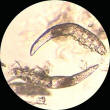
ANSWER: "Most dermatologists will elect not to treat a dog with generalized
demodicosis unless it has been spayed or neutered. The reason for this is simply
due to the high likelihood of the affected dog's offspring to develop
demodicosis. There is absolutely no benefit to NOT spaying or neutering a
dog undergoing treatment. On the other hand, reproductive hormones in female
dogs in heat (estrus) or in pregnant dogs can cause worsening of the mites or
make it more difficult to control them. However, the presence of male
reproductive hormones (un-neutered males) makes no known difference in
the ability to control the Demodex mites. On a different note: I do
not treat dogs with localized demodicosis (less than six affected spots) because
more than 90% of them will resolve on their own. By treating them, you will
never know if the patient would have become a generalized case or not.
QUESTION: Is
Demodex transmissible to my healthy dog from a dog that is infested?
ANSWER: Healthy dogs are quite resistant to infestations and, as
mentioned, may already have a number of mites residing harmlessly in the skin. It is
best, though, to not allow your dog to have direct physical contact with a dog
that has an active case of Demodex... just to be safe.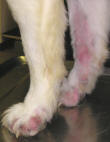
QUESTION: What
about the dog that suddenly develops Demodex later in life and never had
it as a puppy?
ANSWER: This is called Adult-onset Demodicosis and is most commonly
seen in what are assumed to be healthy dogs but that in reality are actually
affected with an underlying pathology or immune compromising disorder.
Therefore, whenever a veterinarian is presented with a case of Demodex in an
adult dog the doctor is alerted to the possibility that there is a potentially
serious underlying disease going on that has compromised the dog's immune
integrity. Such afflictions as cancer, Hypothyroidism, Systemic Fungal Disease, adrenal gland diseases and even exposure to prescribed cortisone medications can allow previously innocuous resident mites to reproduce rapidly and cause visible skin disease. Adult-onset demodicosis is not a genetically programmed disorder. These cases can be difficult to cure unless the underlying stressor is resolved successfully.
DIAGNOSIS
Demodex mites usually create
irregularly shaped, mildly irritated areas of hair loss. 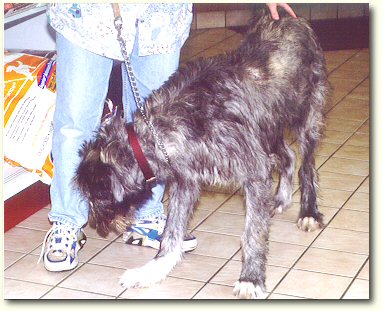 The skin is usually not inflamed and the lesions are not highly pruritic (itchy). Conversely, Sarcoptic mite lesions are very pruritic, inflamed and scabs may be present.
The skin is usually not inflamed and the lesions are not highly pruritic (itchy). Conversely, Sarcoptic mite lesions are very pruritic, inflamed and scabs may be present.
The diagnosis is made by doing a skin scraping of the affected area and placing the scrapings on a microscope slide. Usually the material scraped from the skin is mixed with mineral oil and then examined under the microscope. (NOTE: Sarcoptic mites are rarely visible via skin scrapings and are therefore very commonly misdiagnosed as an allergic skin disorder because the veterinarian "couldn't see any mites". Demodex mites are plentiful and seem to be easily detected via skin scrapings even though they spend most of their time deep in the hair follicles.
HUMAN DEMODEX
Human demodex cases are rather rare but do occur. It is believed that
demodex mites are a common residents of hair follicles in dogs and humans,
and when present in few numbers in a healthy individual seldom cause clinically
observable cases. Under certain unknown conditions, though, humans can
develop clinical cases of demodex mites. The images below are of an animal
caretaker who became infested in the facial regions with demodex mites.
She had been providing the dog with prescribed treatments in the animal
hospital. After consulting with a human dermatologist she was eventually
able to eliminate the mites but the process entailed numerous topical treatments
and also systemic medications. After six months of treatment, all symptoms
of the mites disappeared.
TREATMENT
In dogs with very mild, localized,
small skin lesions some veterinarians do not treat the dog at all. Other
veterinarians will always 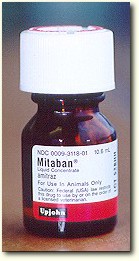 treat a Demodex lesion with topical medications
appropriate as an insecticide. (Some home remedies are harmful so always consult
with your veterinarian about any kind of skin lesion and the safest and most
effective therapy.)
treat a Demodex lesion with topical medications
appropriate as an insecticide. (Some home remedies are harmful so always consult
with your veterinarian about any kind of skin lesion and the safest and most
effective therapy.)
 It is vitally important that all dogs (not just dogs with health problems) be consuming a high quality, meat-based diet with proper amounts of high quality fat. Any dog, especially a growing pup, that is consuming a cheap, grain-based diet will not fare as well as the dog eating a high quality diet. In general, the better diets are higher in price so do not let your decision about what to feed your dog be dictated by the cost. The nutritional aspects of skin disorders is an often overlooked "treatment" and should always be considered when a health impacting situation is present.
It is vitally important that all dogs (not just dogs with health problems) be consuming a high quality, meat-based diet with proper amounts of high quality fat. Any dog, especially a growing pup, that is consuming a cheap, grain-based diet will not fare as well as the dog eating a high quality diet. In general, the better diets are higher in price so do not let your decision about what to feed your dog be dictated by the cost. The nutritional aspects of skin disorders is an often overlooked "treatment" and should always be considered when a health impacting situation is present.
Mitaban was a commonly used treatment for Demodex and had a proven record of successes. This prescription-only product is diluted with water and applied to the dog's skin according to the product directions. Repeated applications are almost always required. This product may no longer be available. On occasion a veterinarian may decide to use a product called Ivermectin. This product must be very carefully calculated regarding dosages that are effective and not toxic. The use of Ivermectin in treating Demodex needs to be discussed with the owner prior to use since it has not been labeled for use against Demodex. Another treatment that is sometimes used is oral milbemycin given daily for six to eight weeks. Lime-Sulphur dips have been used in the past but there are more effective methods that have been favored in recent years.
|
|
|
The dog in this image (a Doberman Pinscher) was severely affected by Demodex skin mites from a very young age. The entire dog was affected. After a year of intensive treatment with dips, Revolution, Ivermectin, Mitaban, antibiotics, vitamins and other remedies, the unfortunate dog was finally euthanized. No treatment or combination of treatments had any affect on the state of the dog's health. Dietary and alternative treatments were attempted but probably because of genetically programmed immunity factors this patient was unable to ward off the parasites and progress to healing. |